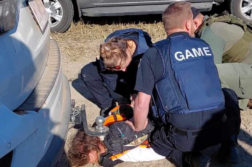On average, foster children have six placements each and 31 per cent attend three or more primary schools, according to a new report by the peak body for children in care, the CREATE Foundation.
The CREATE Report Card 2013 (pdf) surveyed 1069 children in care, aged eight to 11, from all states and territories except Western Australia. It examined how the child protection system was progressing from the perspective of young people living in it.
According to statistics released by the Australian Institute of Health and Welfare, there were 37,648 children and young people in out-of-home care, as of June 2011. This number has been rising steadily over the past few years – up 31 per cent between the years 2007 to 2011.
Author of the report, Dr Joseph McDowell, told New Matilda that the results highlighted the need for children to receive continuity of care and support.
“The Commonwealth Government is now placing as one of its measures for the assessment of the National Standards, the number of young people to have one or two placements,” he says. “That’s the benchmark that they’re setting. If we could have 100 percent of young people in care who have one or two placements they would say that it’s ideal.”
McDowell said that when children are forced to move from one home to the next, their social, mental and educational needs are disrupted and often neglected. “A placement breakdown is disruptive and concerning because the child’s whole location has to be shifted from one place to another,” he says. “When you change placements, you quite often change schools. Children are then taken out of their social context where their friends are and put into a different environment socially and educationally.”
The number of children in out-of-care home completing school was a concerning trend, according to McDowell. Only 33 per cent of young people in out-of-home care complete year 12.
“It’s a vicious cycle,” he says in regard to the number of times children often have to change schools. “Children learn things at different rates, then when they go to a new school, they get behind and don’t know anybody to ask for help.”
The Report Card also found that 35 per cent of kids in care had five or more caseworkers while 50 per cent didn’t even know why they were brought into care.
“When you’re forming relationships that are important and then that person disappears, that’s tough,” McDowell says. “All that they ask really is that someone tells them what’s going on.”
Meanwhile, the situation appears to be far worse for Indigenous youth who are up to 10 times more likely to be in out-of-home care and experience more disruption during their placements.
The report card also found that only 30 per cent of Indigenous young people in care reported any connection with their culture while only 10 per cent were aware of a “cultural support plan”. Nineteen-year-old Jarcinta Short is an Indigeous woman from Tasmania who entered foster care as a newborn.
“I had a lot of placements,” she told New Matilda. She also attended several different primary schools.
“It was a bit awful until the age of 14 – that’s when I found the best carers.
“I just kept getting moved around. Once I’d bonded with the carer, I had to leave and then would have to bond with another carer and then I’d have to leave. It was just a continuous thing.
“Because I moved so many times, I made myself move after I had those bonds taken away from me.”
Short occasionally speaks to her mother but doesn’t know her father. While she has certainly experienced the negatives of the foster care system, Short is grateful for her foster care parents who took her on from the age of 14.
Those parents enabled Jarcinta to stay connected to Indigenous culture – a source of pride. “I don’t think I’ve ever lived with someone who has had the same background as me,” she says. “It’s up to the child. Caseworkers should ask the child what they want.”
Short is currently finishing off her last year at school. She’s out of the foster care system and partakes in the “Moving On” program in Tasmania. The program is designed for kids who have just left the system and teaches them life’s essential skills such as budgeting, getting a job, cooking and cleaning. Short, who will participate in the program until the end of 2014, aspires to be a caseworker herself and plans to start her study next year.
Drawing on the good and bad of her 18 years within the foster care system, she’s now determined to promote change.
“Kids don’t have to be pushed around from place to place,” she says. “It doesn’t teach them to have that bond and if that bond has been taken away from them, they won’t ever connect with anyone or anything.”
Donate To New Matilda
New Matilda is a small, independent media outlet. We survive through reader contributions, and never losing a lawsuit. If you got something from this article, giving something back helps us to continue speaking truth to power. Every little bit counts.



